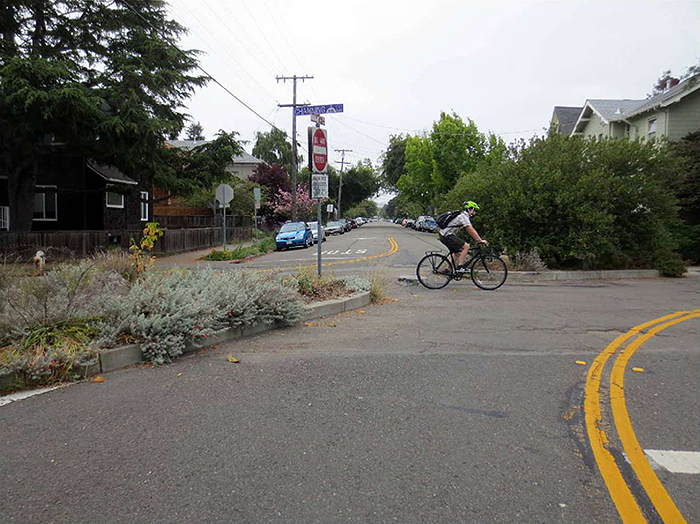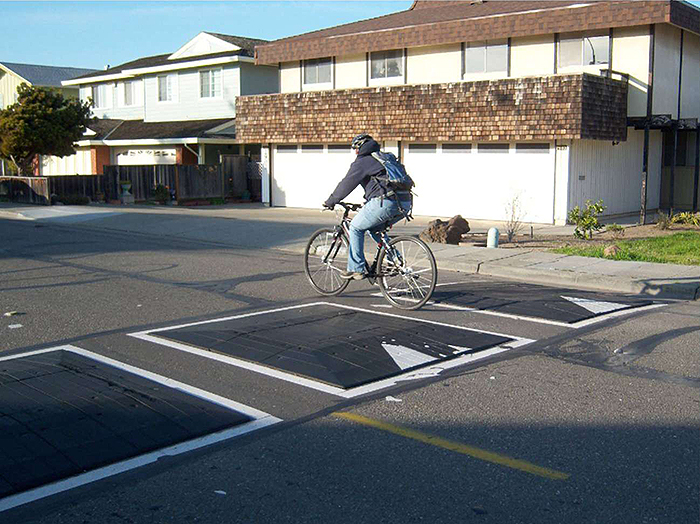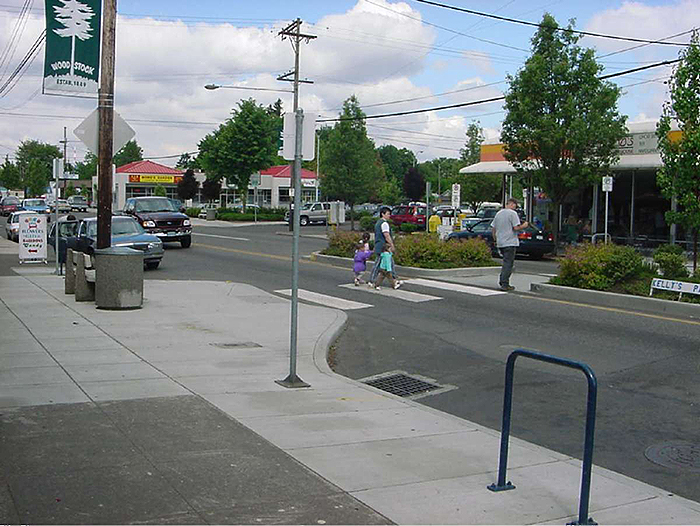U.S. Department of Transportation
Federal Highway Administration
1200 New Jersey Avenue, SE
Washington, DC 20590
202-366-4000
Traffic calming can affect non-motorized users, defined as bicyclists and pedestrians. The following sections discuss these qualitative and quantitative effects. An understanding of how a traffic calming measure can affect a bicyclist or pedestrian enables the selection of an appropriate measure in a location frequented by non-motorized users. In general, bicyclist and pedestrian access should be provided through or around every traffic calming measure.
It is typically advisable to include a pass-through for bicyclists at any routing restriction measure such as a median barrier, diverter, or closure (see Figure 6.1). Bicyclists can be accommodated with two one-way gaps or one gap large enough for two-way bicycle travel. The pass-through refuge should be wide enough for a bicyclist to stop in the median barrier and wait for a gap in traffic without encroaching on the vehicle travel lanes.
A median barrier with a pass-through can positively affect bicyclists and is often an integral part of a bicycle boulevard. The median island reduces the traffic volume on the roadway by restricting the through vehicle movement; at the same time, it allows a bicyclist to pass through the closure.
Signing and striping can be used to advise bicyclists of the pass-through and to alert motorists that bicyclists may be approaching from a non-roadway direction.

Figure 6.1. Bicyclist Using Pass-Through in Diagonal Diverter
(Source: Jeff Gulden)
A vertical measure is generally acceptable to a bicyclist, especially because their effectiveness at reducing vehicle speeds consequently reduces the speed differential between a bicyclist and motor vehicles.
Avoid placement of a speed hump in an area where high bicyclist speed is expected, such as on a steep hill. A bicyclists can safely traverse a 3-inch and even a 4-inch high speed hump at speeds of 15 mph or less. However, a bicyclist approaching a 3-inch hump at 20 mph or a 4-inch hump at 25 mph may lose control.xxxi The ITE Guidelines for the Design and Application of Speed Humps provides additional recommendations such as including a tapered edge so that bicyclists can avoid potential discomfort by passing around the speed hump.xxxii
A speed cushion is a unique measure that can accommodate the mobility needs of both bicyclists and fire vehicles. A bicyclist is able to pass between the cushions without
experiencing vertical deflection (see Figure 6.2). Bicyclists can be directed between the cushions by striping (a current practice in Seattle, WA), an action that can play a major role in the bicyclist being properly alerted to roadway condition changes.

Figure 6.2. Bicyclist Passing Through Speed Cushion
(Source: Jeff Gulden)
A bicyclist can be squeezed or forced to share a travel lane while traveling through a horizontal deflection or street width reduction measure alongside a motorized vehicle. On a street with little bicycle traffic or low vehicle traffic volume, such conflicts are likely to be sufficiently infrequent to not require specific accommodation of bicyclists because the bicyclist can safely take the travel lane.21 Where volumes of both bicycle and vehicle traffic are medium to high (or on a street with a bicycle lane), either (1) provide a bypass lane for a bicyclist, separated from the main travel lane by a curb extension or (2) provide shared lane markings (sometimes known as a sharrow) and "bike may use full lane" signage.
21 This is not to imply that bicyclists should not be considered. They always should. Rather, it is assumed that on a low volume residential roadway, the bicyclist would safely take the lane as legally allowed.
Traffic calming measures that improve street crossing visibility for a pedestrian, shorten the street crossing distance, and reduce the speed and volume of passing vehicle traffic can have positive effects on pedestrian safety and mobility (see Figure 6.3). Raised crosswalks, median islands and barriers (designed to include a pedestrian refuge), corner extensions, chokers, and full and half closures have the most direct and obvious benefits. Both older and younger pedestrians, because of their potentially slower walking speeds, benefit from shorter walking distances.
The safety and mobility of persons with disabilities (including persons who need assistance walking or cannot walk at all, cannot clearly see printed words, have limited cognitive functions, or have limited hearing) can be improved with traffic calming measures. Guidance provided by the Americans with Disabilities Act (ADA) Accessibility Guidelines for Buildings and Facilities (ADAAG) and Public Rights of Way Accessibility Guidelines (PROWAG) should be applied as appropriate.
A 2005 study asked respondents to rate the ability of speed humps, speed tables, and median barriers with a pass-through to accommodate pedestrians. The median barrier with a pass-through rated higher than speed humps or speed tables on improving pedestrian safety.xxxiii Further evaluation of the data pointed to the median barrier with a pass-through as the measure (of the four studied) perceived to provide the most safety for pedestrians.xxxiv
Corner extensions are a common component of walkable urban areas and complete street revitalizations; however, limited study has been completed to determine their effectiveness at increasing driver yielding compliance. Several smaller studies have been conducted with mixed results on driver yielding compliance. A 2005 study in Albany, Oregon found a significant reduction in the number of vehicles that pass prior to yielding for a pedestrian waiting on a curb extension as compared to a non-corner extension location.xxxv The lack of statistical evidence should not deter a practitioner from implementing pedestrian-oriented traffic calming measures as these measures are favorably received by the walking public and not known to adversely affect pedestrian crossings.
 )
)
Figure 6.3. Crosswalk with Bulbout and Median Refuge
(Source: Scott Batson)
